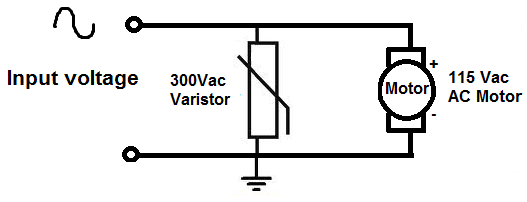How to Build a Simple Varistor Circuit

In this project, we will show how to place a varistor in a circuit so that it can serve its purpose which is to protect electronics from excess voltage and current.
Varistors are components which protect electronic circuitry from excess power such as that offered in the case of transient voltages. Transient voltages are high-magnitude spikes of voltage which can occur in a circuit. They can be caused by a number of factors, such as lightning. Because they offer such a great magnitude of voltage, they can damage electronic components which cannot handle such high power levels. Varistors placed in parallel to a circuit can protect it by shunting the excess voltage to ground so that the excess power doesn't damage sensitive electronics that cannot handle it.
Below is how varistors are placed in circuits so protect them from possibly damaging excess power:

You can see below how a varistor is placed in parallel to the circuit it needs to protect and that it's connected directly to ground.
This is how a varistor works in a circuit:
When the voltage to a circuit is low or within acceptable limits, the varistor has a very high resistance. Since the varistor has such a high resistance, current does not flow through it; instead it flows to the device which needs power in the circuit. Remember that current always takes the path of least resistance. The majority of current goes through the path of least resistance.
However, if the voltage exceeds a certain threshold, the varistor's resistance drops. As it drops, current begins
to flow through it, since it offers less and less resistance. In this way, it diverts the excess voltage safely to ground instead
of through the electronic circuitry. The more the AC line voltage increases, as it does in a serious power surge, the more the varistor's
resistance drops. So more and more current will flow through the varistor during a great power surge, since it offers such
small resistance when voltage is great.
So now let's put together a very simple varistor circuit with an AC motor which protects it from transient voltages.
The components needed to build this circuit are shown below:
Components
- 300Vac Metal Oxide Varistor
- 115V AC Motor
- 120Vac Transformer
The circuit we will build is shown below:

This MOV circuit will clamp up to 300Vac if a power surge allowing transients into the circuit were to be that high. In the event of receiving this voltage, the MOV would
clamp and shunt the excess power safely to ground, so that the excess current would not flow through the AC motor but through the varistor. In this way, it protects the AC motor from voltage
spikes.